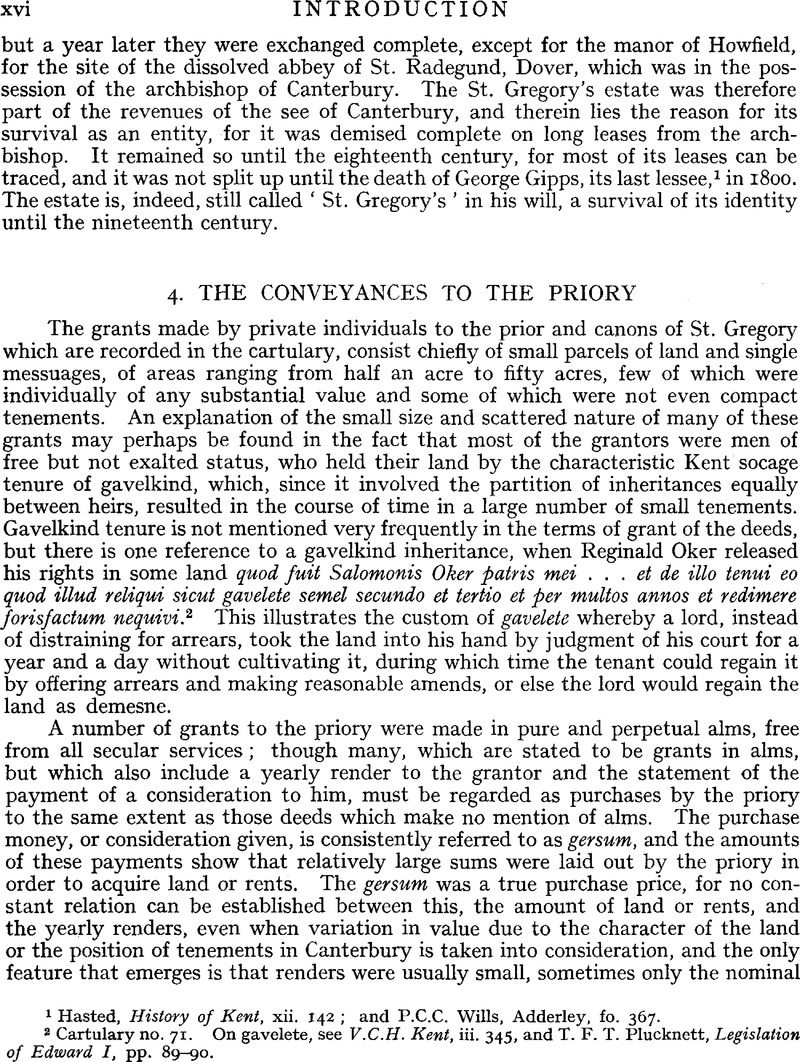No CrossRef data available.
Article contents
4. The Conveyances to the Priory
Published online by Cambridge University Press: 24 December 2009
Abstract

- Type
- Introduction
- Information
- Copyright
- Copyright © Royal Historical Society 1956
References
page xiv note 2 The tithes of Waltham are described in archiepiscopal confirmations as tarn militum quam rusticorum.
page xiv note 3 Domesday Monachorum, V.C.H. Kent, iii. 235.
page xiv note 4 Book of Fees, p. 1346 and p. 1381.
page xiv note 5 Abbreviatio Placitorum (Record Commission), p. 39b, and Bracton's Notebook, ed. F. W. Maitland, no. 704.
page xv note 1 Hasted, History of Kent, iii. 240.
page xv note 2 This supports the theory that the denns in the weald were used as pasture for animals from more distant parts of Kent. See Cartulary of Bilsington Priory, ed. N. Neilson, pp. 22–3.
page xv note 3 The statement in Dugdale's Monasticon (iv. 658) that the nuns were re-established and their possessions confirmed to them by Archbishop Boniface appears to be an error. A transcript of this confirmation, giving the archbishop's name as Boniface, is given in Bodl. Tanner MS. 223, fo. 52V., but in Lambeth MS. 1212, a more reliable version of the same Register, the initial B. only is given, with a marginal identification as Baldwin, which the names of the witnesses corroborate. In this case the confirmation was made before the dissolution of the house and there is no evidence of its re-foundation.
page xv note 4 A Harrow court roll of 1513 (transcript supplied by Mr. Percy Davenport, from a document in his possession) states, among complaints about the decayed condition of Bentley, that it had been founded by an archbishop of Canterbury who had given it to St. Gregory' priory, and ‘ time out of mind in the immemorial past’, a canon of the priory had served Bentley.
page xv note 5 Matthew Paris, Chronica Majora (Rolls Ser.), v. 33.
page xvi note 1 Hasted, History of Kent, xii. 142; and P.C.C. Wills, Adderley, fo. 367.
page xvi note 2 Cartulary no. 71. On gavelete, see V.C.H. Kent, iii. 345, and T. F. T. Plucknett, Legislation of Edward I, pp. 89–90.
page xvii note 1 See Feudal Documents of the Abbey of Bury St. Edmund's, ed. D. C. Douglas, p. cliii.
page xvii note 2 Cartulary nos. 112–15.
page xvii note 3 See also M. Adler, ‘ The Jews of Canterbury ’, Jewish Hist. Soc. Trans., vii. 19 ff.
page xviii note 1 Cartulary no. 68.
page xviii note 2 Appendix I. 2.
page xviii note 3 Cartulary no. 152.
page xviii note 4 Facsimiles of Charters in the British Museum, ed. G. F. Warner and J. Ellis, nos. 68 and 69.
page xviii note 5 Cartulary no. 172.
page xviii note 6 Cartulary no. 114.
page xix note 1 The cartulary of the priory of St. Radegund, Dover (Bodl. Rawlinson MS. B 336, pp. 105–9), contains grants mentioning Northgate court and the burgimote of Canterbury; and the charters of Eastbridge Hospital (transcripts made by Mr. W. Urry) often mention the hundred court and the archbishop's court. But various charters survive relating to the Northgate area (D. & C. Cant., Cart. Ant. C. 971, 973, 970, 1034, etc.) which, dated 1235–51, mention no courts, which seems to set the period when this clause was habitual as somewhat earlier.
page xix note 2 This would account for the mention of two hundred courts in one document, e.g. no. 74, sigillo meo firmiter munita et facta et recordata in burgimoto ciuitatis Cant' et in hundredo berthe de Northgate et de Westgate.… in a charter granting a house in Northgate ward from which a yearly render was paid to Westgate court.




